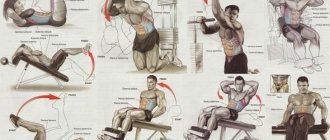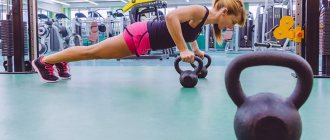Full text of the article:
People who frequent fitness centers have probably at least heard of interval training.
. The essence of such training is approximately clear from the name. Interval training involves alternating periods of intense physical activity with periods of recovery. All this happens during one lesson. It turns out that a person experiences an uneven load, and the body is forced to constantly adapt to new conditions.
What is the difference between the interval training method?
It would seem that the very essence of training is to develop certain qualities and abilities in a person, therefore the duration and intensity of training must be slowly but systematically increased. What is so special about interval training?
Fitness instructors believe that interval training is more effective than classical training. Alternating periods of “activity” and “rest”
allows you to make the overall workout more intense and burn more calories. Interval training will be especially useful for people who want to lose weight.
How to train properly
You should not start interval training on your own; this type of training is not suitable for everyone; you should first consult a doctor to make sure there are no contraindications. The main contraindications to interval training may be associated with the presence of cardiovascular diseases.
. People with heart disease are contraindicated for high-intensity exercise, although they can and should still play sports. An alternative would be Nordic walking, but interval training would have to be abandoned.
Although interval training seems easier than classical training due to the “rest” periods, this is far from true. To get into interval training, you need to have some physical fitness. To test your strength, start doing cardio workouts
and gradually increase their duration. If this doesn't make you feel worse, you can try interval training.
You also need to start gradually. During the first training sessions, short periods of intense exercise will suffice. Keep them no longer than 30 seconds.
, this will make it easier for you to control your condition and regulate the load. At the same time, periods of light activity may be longer, allow yourself to rest. Interval training does not mean that the “load” and “rest” intervals must be the same.
Advantages and disadvantages
Advantages:
- uniform load on all muscle groups;
- figure correction;
- injury prevention;
- development of endurance;
- fat burning, weight loss, drying;
- health promotion;
- detailed training management from start to finish;
- taking into account individual characteristics: the number of approaches and repetitions is determined based on physical fitness;
- variety of classes: it is possible to train both in the gym on simulators and at home without sports equipment.
Flaws:
- high energy costs are incompatible with low-carbohydrate nutrition systems;
- it is difficult to work out any specific muscle group, since everything is trained evenly;
- problems in group classes: rest time intervals, as well as the number of repetitions, may not coincide - then the overall team spirit is lost and hitches form;
- the presence of contraindications: heart problems, fever, recent operations, injuries;
- an incorrectly chosen training regimen always carries a high risk of overtraining and injury.
How to Create an Interval Training Plan
Any workout should start with a warm-up
, muscles and joints need to be prepared for increased stress. To make your muscles more elastic and reduce the likelihood of sprains, you need to warm up your body well. The set of basic exercises can be different, the main thing is that they involve different muscle groups.
During your first interval training, it is better to alternate between walking and jogging.
, and walking intervals can be significantly longer than jogging intervals. It is important to monitor your health, especially your pulse. If you feel dizzy or experience other undesirable symptoms while jogging, you need to switch from running to walking or stop training. During running, your heart rate increases, but during the recovery phase it should decrease and be no more than 30-40% higher than your typical resting heart rate.
At the beginning of your workout, determine the duration of the intense intensity interval for yourself and do not increase it throughout the entire workout. If the load seems insufficient to you, raise the bar for the next lesson. Although it’s still not worth increasing the load sharply. There is a popular “ten percent” rule.
, according to which you need to increase the load by no more than 10% per week, then the body will not experience severe stress.
Don't work too hard. The workout should provide you with a challenge, but the challenge should not be excessive. If you feel pain or your heart rate increases too much, you should stop training. Signs of fatigue or overload may appear suddenly or increase gradually; learn to listen to your body and not ignore its signals.
Intense workout to burn fat and build muscle
Before you start a weight loss exercise, you should warm up. Here's an example of a warm-up:
- Head tilt – 1 set of 10 reps
- Neck Rotation – 1 x 10
- Shoulder Rotation – 1 x 10
- Arm Circles – 1 x 10
- Wrist Rotation – 1 x 10
- Waist rotation – 1 x 10
- Ankle Rotation – 1 x 10
- Calf raises – 1 x 10
- Side Lunges – 1 x 10
- Jogging in place – 3 minutes
- Standing Side Crunch – 1 x 10
Now that you have prepared your body for an intense fat-burning workout, you can begin. I developed a full body HIIT workout program. It consists of 3 cycles, including 3 rounds of HIIT exercises for 30 minutes.
What should the load interval be?
Beginners often think that the load intervals in interval training should be long and take at least a few minutes, but here the count is not in minutes, but in seconds. It is better to do more intervals, but keep them short, from 6 to 30 seconds
. In this case, you can be sure that the body will really work under increased load, and you will “give your best” to the fullest.
Any load must be justified, otherwise you risk harming yourself. During the specified interval, the muscles will be able to produce a sufficient amount of lactic acid
, but not to spend too much energy, which could lead to damage. For amateur sports, long intervals of increased load are not needed; the longer the interval, the more difficult it will be to control the load, especially if you are exercising without an instructor.
For professional athletes, the duration of intense exercise intervals can reach three minutes, but you need to understand that during this time the muscle need for oxygen and glycogen will greatly increase, and with it the risk of damage. It takes many months, or even years, to prepare for such loads, so it is better for beginners to stay in the range of 5-30 seconds
.
Books
The Internet contains thousands of books on weight loss and sports training, however, how to choose the best copy that will be convenient for you to learn new exercises, and most importantly, to practice successfully?
Today we can highlight the following printed publications for interval training:
“HIIT” is a detailed manual on intensive training that is suitable not only for experienced athletes, but also for beginners.
“7 Minutes for Fitness” - the book has long won a place on the bookshelf of sports mothers and people with little time for sports. The guide will help you not only understand the training system, but also properly motivate you for new achievements in sports.
What should the recovery interval be?
The principle of interval training is to alternate periods of stress and periods of recovery. They should not be equal, but should correlate with each other in a ratio of approximately 1:6
.
If the load period lasted about 10 seconds
, then recovery will take about a minute.
This is not a strict addiction, the body recovers differently in different people, so you need to rely mainly on your own sensations, and not on the timer. During the recovery period, breathing should calm down and heart rate should decrease by 50-60%
. Tension should also disappear in the muscles; if this does not happen, then extend the recovery interval. If the measures taken also do not help the body return to normal, and the muscles hurt or remain tense, then end the workout.
How many intervals should there be in one workout?
You can adjust the number of intervals yourself depending on your physical fitness and general condition. Listen to your body. If you begin to experience muscle pain, tension does not go away, shortness of breath appears, and your heart rate does not recover, then you need to complete the workout, even if you did not manage to complete the usual number of intervals. You can't overcome the pain. If you are too tired, then the training will be less effective; you should not wait until your “second wind” opens.
Can I do interval training every day?
Interval training is considered high intensity training. If you have had a long workout or are not in good physical shape, then allow at least two days for your body to recover. But this does not mean that any physical activity is contraindicated for you the next day. Instead of interval training, you can do a set of exercises to strengthen your heart.
It is important to prevent the body from overworking. Signs of “overtraining” may include:
:
- rapid heartbeat at rest, which persists even the next day;
- muscle pain;
- persistent feeling of extreme fatigue.
Content
- 1 Interval training for fat loss 1.1 Benefits of interval training
- 3.1 Kettlebell or dumbbell swings
- 5.1 Tabata Protocol
One of the options for interval training for beginners
There is no general plan for interval training; it must be developed individually and adjusted depending on the general condition of the body. Let's offer just one of the possible scenarios:
- Start with a warm-up
. To warm up your muscles, 5-10 minutes will be enough. During this time, try walking at a fast pace or jogging a little, doing a few bends and squats. - Make a more intense burst
and run for a few meters at a speed that is approximately half your maximum running speed. This will help the body “get the blood flowing” in the muscles and prepare for an increase in load. As a result, you should feel that your muscles have warmed up and warmth has spread throughout your body. - From this point on, you can begin to alternate jogging with running at maximum speed
. It is recommended to jog for about a minute, and then accelerate for 5-6 seconds. In order not to be distracted by a stopwatch, you can measure time “at hand”; it is believed that in 6 seconds a person can pronounce three three-digit numbers. Of course, you need to do this mentally so as not to lose your breath. - After the acceleration interval, you need to return to the rest interval
, but you cannot stop; if it is difficult for you to constantly jog, then switch to a walk. - For the first workouts, it is enough to complete 10-20 intervals
, so in total you will spend about half an hour on training. But if you feel that your muscles have begun to ache, and the tension does not subside even during periods of rest, then it is better to complete the workout. - You need to end interval training not abruptly, but gradually
. Switch from running to walking and walk briskly for at least 5-10 minutes.
Scheme for beginners
Every sport has ready-made HIIT protocols that professionals use. Beginners need a personalized plan that takes into account age, weight and health status, as well as the result they want to get. Therefore, a doctor and a trainer should draw up a plan and schedule of classes in tandem. There are certain principles of HIIT for beginners:
- warm-up and cool-down - at least 5 minutes;
- rest phase – 2 times longer than the active stage;
- intensive session - no more than 15 seconds;
- recovery period - at least 48 hours.
Thus, the training will take about 15 minutes, during which active loads will last only 5 minutes, and the rest of the time will be spent accelerating and slowing down the heart rate.
Calculation of maximum heart rate
It is imperative to purchase a heart rate monitor, timer or fitness bracelet, since heart rate dynamics is the basis of the technique. It is also important to calculate your heart rate limit. This can be done using the Haskell-Fox formula, where the maximum heart rate of 220 beats per minute is considered the limit.
- for women MCSR: 206-(0.88 * age);
- for men MCSR: 208-(0.7 * age).
The maximum load for an untrained middle-aged person is 85% of the calculated MHR and rest is 50% of the MHR.
Calculation example: for a 35-year-old man, the MOHR is: 208-(0.7*35) = 183 beats per minute.
This means that the maximum permissible heart rate during an intensive exercise interval will be 155-156 beats per minute (85% of 183), and during the rest period the figure should drop to 90-91 beats (50% of 183). By monitoring your heart rate, you can judge the effectiveness of your exercise.
Nutrition and lifestyle
Exercising to the limit, even for just a few minutes, is a real test for the heart, respiratory and metabolic systems. Heavy interval training is prohibited if smoking or drinking alcoholic beverages occurs in the life of the novice athlete. During the course, you need to give up these bad habits.
It is also worth postponing HIIT if you are on a low-carb or mono diet. And for those who are tired of constant malnutrition for the sake of a slim figure, it will be good news that you need to increase your daily diet by 500-1000 kcal on the day of training, that is, consume at least 2000 kcal.
The ratio of BJU will directly depend on the expected result:
- for weight loss and fat burning: B (40) : F (40) : U (20);
- for gaining muscle mass: B (30-35) : F (15-25) : U (45-50).
A simple formula per kilogram of weight per day will help you calculate the rate of grams consumed:
- protein 2 g;
- fat 1 g;
- carbohydrates 2 g.
Before and after training, amino acids and L-carnitine are allowed for the entire duration of the HIIT course in a dosage of up to 1000 mg per day.
The principle of intermittent fasting is that you need to consume food during the hours of greatest activity, and spend 6-8 hours a day without food. This is the period when you need to completely avoid any snacks and drinks.
American trainers and nutritionists have developed the “100 days to an ideal figure” system, which combines HIIT workout and intermittent fasting. This approach is used to treat obesity. The popularity of the complex is explained by the fact that 30% of extra pounds are easily removed in the first 6 weeks of classes. At the same time, a person feels quite comfortable, as he can adjust his diet and exercise to his normal rhythm of life. A survey of those who tried the system on themselves showed that the following daily and nutritional regimen was the most convenient and painless for a person:
- increasing the duration of sleep to 10 hours a day, divided into night and daytime;
- division of nutrition according to the principle: in the morning the maximum amount of fat and some carbohydrates;
- protein-carbohydrate lunch after training and nap;
- protein dinner three to four hours before bedtime.
In the first 6 weeks, you can use the 14/10 scheme, where meals and physical activity are allowed for 10 hours, and sleep and fasting time is 14 hours.
Things to remember
Interval training is considered more effective than classical training, during which the load gradually but constantly increases. During interval training, the body burns more fat, and along with it, calories. However, you should switch to interval training only after receiving your doctor's approval.
You need to start training gradually and do not forget about warming up. The load also needs to be increased gradually. Interval training cannot be done every day; it is optimal to train 2-3 times a week. It is recommended to do cardio between interval training sessions.
During training, you need to carefully monitor the condition of your body and avoid overloading. Muscle pain and spasms should not be tolerated. When the first signs of fatigue appear, you need to complete the workout.
Example programs
Interval training is a method that is widely used in many sports areas.
Run
High-intensity interval running training is carried out in an athletics arena or stadium. This is due to the fact that these sports facilities have marked segments of standard length. This allows you to more accurately follow high-intensity intervals and maintain the required pace.
Interval training for beginners consists of 3-5 cycles of load and rest. The lesson begins with slow jogging at a frequency of up to 60% of the maximum heart rate. Its duration depends on the physical readiness of the athlete and ranges from 200 to 400 m.
The non-stop rest interval is followed by a 100m sprint at a heart rate (HR) of up to 80% of your maximum. As the athlete's training increases, the relationship between the stages of each cycle changes.
Exercise bike
Interval training on an exercise bike is very similar in structure to running. In both cases, you should remember to warm up and warm up before starting the exercises.
The main difference between an exercise bike is that exercise can be done based on the distance or time covered. Also, some models of this sports equipment are equipped with a function for changing the force when rotating the pedals.
In this case, it becomes possible to conduct strength training that simulates driving uphill. The first stage with heart rate up to 55-65% of the maximum for beginners is 300-400 m or 2.5-3 minutes. This is followed by a high load of 100 m or 1-1.5 min. After this, the cycle repeats again. It is important to avoid stops and pauses throughout the exercise.
Interval fitness
With this type of intense load, the rest period should be equal to the time the exercises are performed. Interval fitness can be more accurately described by the phrase circuit training. The athlete selects 5-6 basic exercises of aerobic and anaerobic type. You can perform them at the initial stage, 2 or 3 at one interval.
Interval fitness mix training uses a method in which the athletics aerobic part of the session is a rest period. An athlete's heart rate when running should not fall below 50-55% of the maximum.
On the press
Exercises to work the abdominal muscles are based on the Tabata system. In this case, classic twists or leg lifts are performed from a lying position. Also, the training program may include static exercises with dynamic elements. An example of such a workout is the combination of plank and climber.
To perform the exercise you need to position yourself as follows:
- The body is smooth and in a horizontal position.
- The arms are straight and located in the same plane as the shoulders. The palms are pressed tightly to the floor surface.
- The legs are brought together, the toes of the feet are located together.
From this position, movements of the legs bent at the knees towards the chest are carried out. The exercise is performed at a sharp, explosive pace. Therefore, before starting a workout, it is important to do a good warm-up.
Kettlebell workout to burn fat
Sports activities with a kettlebell for weight loss include basic movements with this equipment. During the exercise, the muscles of the back, chest, legs, arms and abdomen are involved.
The construction of interval training with a kettlebell or dumbbells is carried out according to the Fitmix principle:
- Swings with a kettlebell are performed as follows: the projectile is fixed on outstretched, straight arms in front of the chest. Legs are straight, knees slightly bent. From this position the weight is lowered down. During movement, you need to monitor the position of your back. Excessive deflection in the lumbar region is not allowed.
- Jerk . The exercise is performed with one hand. The muscles of the entire body are involved in the process of performing the movement. The snatch exercise develops endurance and flexibility of the shoulder girdle.
- Squats . The kettlebell is placed in front of the chest on bent arms. When performing the exercise, bending in the lumbar and thoracic spine is not allowed.
- The Turkish get-up engages the stabilizer muscles. The essence of the exercise is to lift the body with a weight from a lying position. The projectile must be held in a straight, outstretched hand.
The Turkish get up exercise is performed in 4 stages:
- From a horizontal position (weight in your right hand), lift your body with support on your left elbow. The right leg is bent at the knee so that the shin is perpendicular to the floor.
- The right thigh rises to be in line with the body. The left arm is straightened with the fulcrum on the hand. At this moment, the athlete’s position is similar to the position he occupies during a side plank.
- The left leg is pulled back, the body is moved to a vertical position with support on the knee of the left and the foot of the right leg.
- Final rise to a standing position.
During the movement, the hand with the weight is directed vertically upward.
Cardio workout for drying the body outdoors
Aerobic exercises in the open air can be represented by 4 types of load:
- run;
- a ride on the bicycle;
- walking;
- swimming or rowing.
The first 2 types are discussed above. Water sports are not widely available. Sports activities based on walking are based on the Tabata principle. Intervals of fast steps lasting 30-60 seconds should be followed by a light walk of 2.5-5 minutes.
Unusual circuit strength training
Circuit training in the gym is based on the principles of Fitmix. The purpose of this sports activity is to create intense continuous tension in large muscle groups.
To do this, perform the following exercises:
- Hanging leg raises 20 times.
- Walking lunges 40 reps.
- Climber 15-20 per leg.
- Burpee 20 times.
- Push-ups with stepping to the side and back 15-20.
- Squats with the leg laid back (on a support) 15-20 on each leg.
- Crunches with legs bent and raised, 20-25 repetitions.
The listed exercises form 1 full high-intensity interval. Beginning athletes can separate it with short periods of rest. The number of intervals must be at least 3.
Workout to burn fat at home
For intensive fat burning at home, a circular training technique is used. You can apply the previously described training program. No special equipment is required to perform it.
Joint strength training with a partner
Sports activities with a partner provide additional motivation. High-intensity interval training with an assistant is based on the Fitmix system.
Basic movements from individual areas of functional training are combined together and form a training program:
- Handshake push-ups. Athletes sit opposite each other, linger at the top point of the amplitude and shake hands. The exercise is a combination of dynamic and static loads.
- Reverse push-ups with emphasis on your partner's palms . When performing a movement, a large number of stabilizer muscles are involved in the work.
- Raising arms through the sides with resistance . The advantage of this method is the ability to regulate the load along the entire trajectory of movement.
- Leg press . The partner lies down on the floor and rests his feet on his partner’s back. Next, flexion and extension of the legs are carried out.
- Partner's pull towards the lower abdomen . From the position of rowing the barbell to the belt. One athlete is placed horizontally. The pull occurs behind the shoulder.
Swimming
High-intensity swimming training can be built using either the Tabata protocol or the Waldemar Gerschler method. At the same time, the warm-up in both cases 1 and 2 should be thorough. Particular attention should be paid to working out the shoulder girdle.
Interval training, regardless of the type of sport and the nature of the load, is an effective way to normalize weight and tone the body muscles.
The speed of obtaining results is determined by a professionally selected training program. High-intensity exercise is a significant stress for the human body, so it should be practiced no more than 1-2 times a week.











